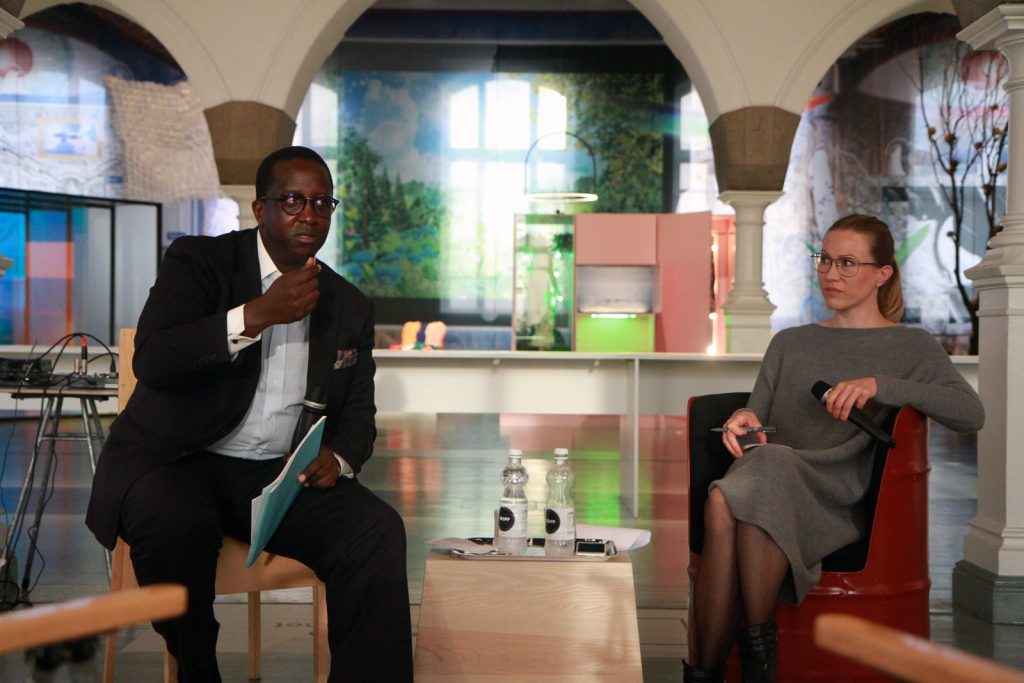Pragmatism, light and nature: How Finnish design contributes to peacemaking?
According to CMI’s Itonde Kakoma, Finland should take advantage of its design expertise to support peace mediation. Peace negotiators don’t pay enough attention to how right kind of environment can nurture political will between conflict parties, Kakoma said in a discussion at the Finnish Design Museum.

CMI’s Itonde Kakoma and creative director Heini Lehtinen discussed about peace and design at the Finnish Design Museum.
On Tuesday the Finnish Design Museum in Helsinki hosted a discussion that one doesn’t come across that often. Itonde Kakoma, CMI’s Head for Sub-Saharan Africa, was interviewed by creative director and writer Heini Lehtinen on the intersections between peace and design. The event launched Design Museum’s series of six discussions with curators.
Lehtinen said that the idea for the discussion came from the fact that we live in time of growing tensions. Design of spaces is one way of alleviating confrontation between people. The Design Museum’s current exhibition “Enter and Encounter”, co-curated by Lehtinen, explores the role of design and societal change.
Kakoma has recently studied the process of peace negotiations from the perspective of design.
“As practioners of peace, we haven’t really explored basic elements of design and architectural thinking in terms of how we convene parties for dialogue. I think that’s a problem.”
A new dimension to Finnish expertise on peace mediation?
Kakoma emphasized that both peace mediation and certain forms of design ultimately have the same purpose: to enable encounter of people. Kakoma said that Finnish interior design and architecture, for example, have special qualities in creating a suitable environment for peace negotiations.
“Pragmatism, playfulness, appreciation for light,” Kakoma enumerated.
Kakoma reminded the audience that Finland and its remote villas, for example, are often a venue when CMI brings conflict parties together.
Lehtinen agreed with her interviewee. She highlighted the closeness to nature as a calming element. In addition, Finnish design celebrates equality.
“All of these are strengths that our design has in connecting people.”
In Kakoma’s view design thinking could add a new dimension to the internationally well-recognized Nordic and specifically Finnish expertise on peace mediation. He encouraged both peacemaking and design professionals to explore cooperation in defining suitable spaces for peace negotiations.

CMI’s Sub-Saharan Africa and Middle East and North Africa teams discussed regional dimensions of conflicts at an informal meeting at the Swedish embassy in Helsinki. Photo: Riku Isohella
“It was the environment that freed the conflict parties from distractions”
According to Kakoma, contemplating design makes sense especially in CMI’s case. CMI convenes conflict parties often in an informal manner. When removed from the pressure of the public eye in official peace processes, conflict parties at times demonstrate a willingness to move beyond formal rhetoric into a posture of dialogue.
In some sense, it’s about removing unnecessary obstacles so as to nurture their willingness to engage in dialogue.
“If we don’t pay attention to environments in which we convene, we potentially undermine or distract from nurturing political will. This is not to say that the right kind of environment leads to the peaceful resolution of a conflict. But it plays a role.”
Kakoma makes a comparison to illustrate the importance of environment in making peace. He recalled a peace process supported by CMI on the outskirts of a remote town in East Africa. The forests and mountains created a setting for a more human-centered and less power-driven atmosphere.
“It was the environment that freed the conflict parties from distractions and enabled them to re-encounter one another towards advancing peaceful dialogue.”
Antti Ämmälä/CMI